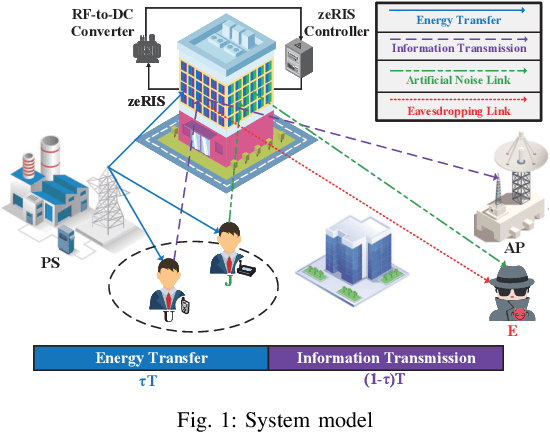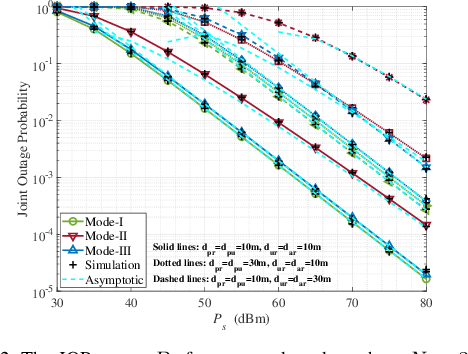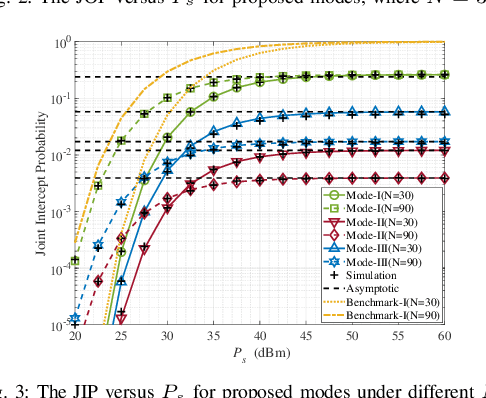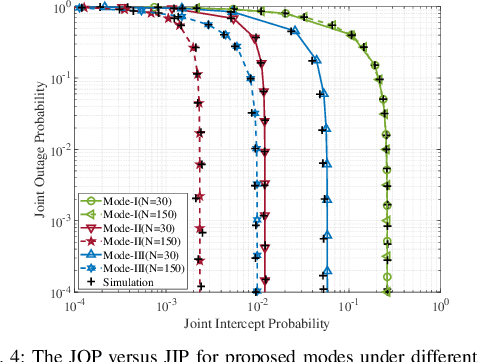Lu Lv
Secure Wireless-Powered zeRIS Communications
Mar 10, 2025



Abstract:This paper introduces the concept of wireless-powered zero-energy reconfigurable intelligent surface (zeRIS), and investigates a wireless-powered zeRIS aided communication system in terms of security, reliability and energy efficiency. In particular, we propose three new wireless-powered zeRIS modes: 1) in mode-I, N reconfigurable reflecting elements are adjusted to the optimal phase shift design of information user to maximize the reliability of the system; 2) in mode-II, N reconfigurable reflecting elements are adjusted to the optimal phase shift design of cooperative jamming user to maximize the security of the system; 3) in mode-III, N1 and N2 (N1+N2=N) reconfigurable reflecting elements are respectively adjusted to the optimal phase shift designs of information user and cooperative jamming user to balance the reliability and security of the system. Then, we propose three new metrics, i.e., joint outage probability (JOP), joint intercept probability (JIP), and secrecy energy efficiency (SEE), and analyze their closed-form expressions in three modes, respectively. The results show that under high transmission power, all the diversity gains of three modes are 1, and the JOPs of mode-I, mode-II and mode-III are improved by increasing the number of zeRIS elements, which are related to N2, N, and N^2_1, respectively. In addition, mode-I achieves the best JOP, while mode-II achieves the best JIP among three modes. We exploit two security-reliability trade-off (SRT) metrics, i.e., JOP versus JIP, and normalized joint intercept and outage probability (JIOP), to reveal the SRT performance of the proposed three modes. It is obtained that mode-II outperforms the other two modes in the JOP versus JIP, while mode-III and mode-II achieve the best performance of normalized JIOP at low and high transmission power, respectively.
Covert Communications in Active-IOS Aided Uplink NOMA Systems With Full-Duplex Receiver
Feb 05, 2025Abstract:In this paper, an active intelligent omni-surface (A-IOS) is deployed to aid uplink transmissions in a non-orthogonal multiple access (NOMA) system. In order to shelter the covert signal embedded in the superposition transmissions, a multi-antenna full-duplex (FD) receiver is utilized at the base-station to recover signal in addition to jamming the warden. With the aim of maximizing the covert rate, the FD transmit and receive beamforming, A-IOS refraction and reflection beamforming, NOMA transmit power, and FD jamming power are jointly optimized. To tackle the non-convex covert rate maximization problem subject to the highly coupled system parameters, an alternating optimization algorithm is designed to iteratively solve the decoupled sub-problems of optimizing the system parameters. The optimal solutions for the sub-problems of the NOMA transmit power and FD jamming power optimizations are derived in closed-form. To tackle the rank-one constrained non-convex fractional programming of the A-IOS beamforming and FD beamforming, a penalized Dinkelbach transformation approach is proposed to resort to the optimal solutions via semidefinite programming. Numerical results clarify that the deployment of the A-IOS significantly improves the covert rate compared with the passive-IOS aided uplink NOMA system. It is also found that the proposed scheme provides better covert communication performance with the optimized NOMA transmit power and FD jamming power compared with the benchmark schemes.
Safeguarding Next Generation Multiple Access Using Physical Layer Security Techniques: A Tutorial
Mar 25, 2024



Abstract:Driven by the ever-increasing requirements of ultra-high spectral efficiency, ultra-low latency, and massive connectivity, the forefront of wireless research calls for the design of advanced next generation multiple access schemes to facilitate provisioning of these stringent demands. This inspires the embrace of non-orthogonal multiple access (NOMA) in future wireless communication networks. Nevertheless, the support of massive access via NOMA leads to additional security threats, due to the open nature of the air interface, the broadcast characteristic of radio propagation as well as intertwined relationship among paired NOMA users. To address this specific challenge, the superimposed transmission of NOMA can be explored as new opportunities for security aware design, for example, multiuser interference inherent in NOMA can be constructively engineered to benefit communication secrecy and privacy. The purpose of this tutorial is to provide a comprehensive overview on the state-of-the-art physical layer security techniques that guarantee wireless security and privacy for NOMA networks, along with the opportunities, technical challenges, and future research trends.
Is the Performance of NOMA-aided Integrated Sensing and Multicast-Unicast Communications Improved by IRS?
Jul 26, 2023Abstract:In this paper, we consider intelligent reflecting surface (IRS) in a non-orthogonal multiple access (NOMA)-aided Integrated Sensing and Multicast-Unicast Communication (ISMUC) system, where the multicast signal is used for sensing and communications while the unicast signal is used only for communications. Our goal is to depict whether the IRS improves the performance of NOMA-ISMUC system or not under the imperfect/perfect successive interference cancellation (SIC) scenario. Towards this end, we formulate a non-convex problem to maximize the unicast rate while ensuring the minimum target illumination power and multicast rate. To settle this problem, we employ the Dinkelbach method to transform this original problem into an equivalent one, which is then solved via alternating optimization algorithm and semidefinite relaxation (SDR) with Sequential Rank-One Constraint Relaxation (SROCR). Based on this, an iterative algorithm is devised to obtain a near-optimal solution. Computer simulations verify the quick convergence of the devised iterative algorithm, and provide insightful results. Compared to NOMA-ISMUC without IRS, IRS-aided NOMA-ISMUC achieves a higher rate with perfect SIC but keeps the almost same rate in the case of imperfect SIC.
 Add to Chrome
Add to Chrome Add to Firefox
Add to Firefox Add to Edge
Add to Edge